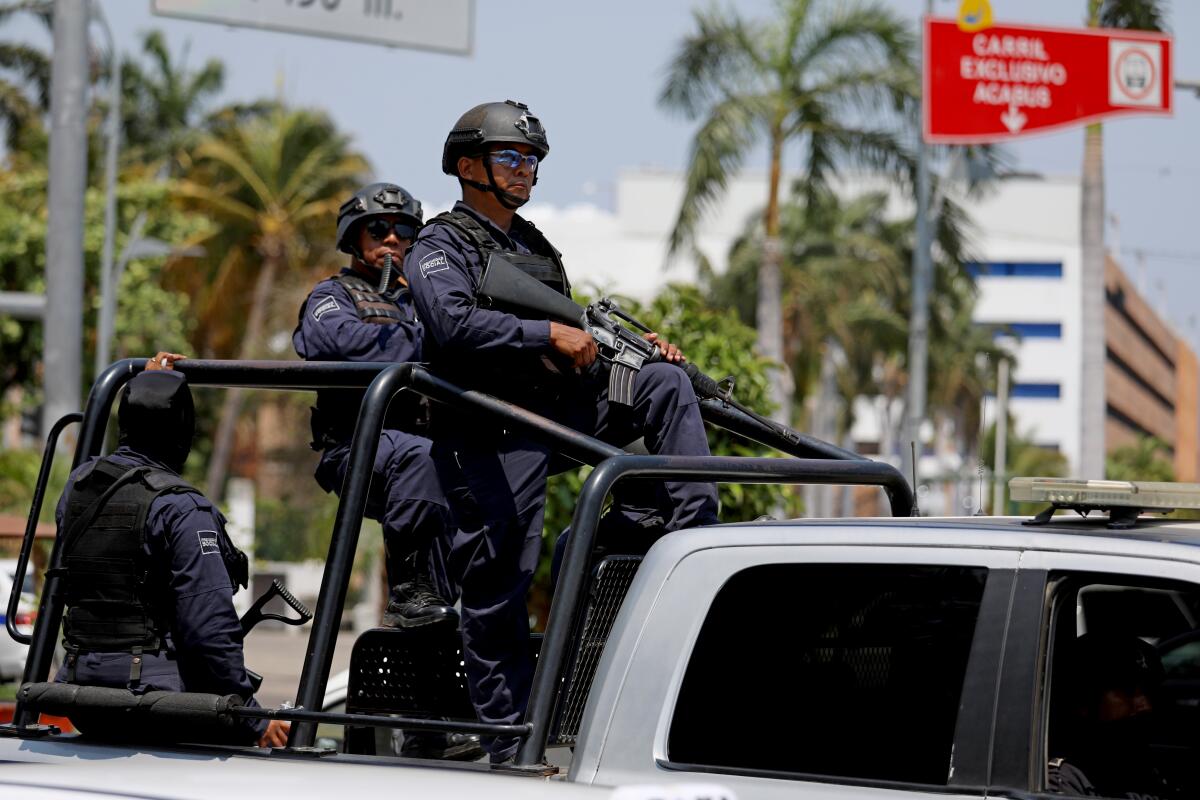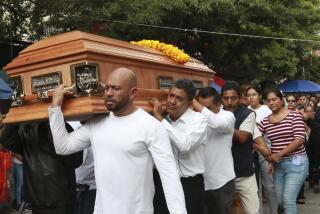14 police officers killed in an ambush in Mexico, testing president’s security strategy

- Share via
MEXICO CITY — A police convoy was passing through a small town in western Mexico on Monday morning when bullets began to fly. It was an ambush by one of Mexico’s most violent criminal groups.
In a matter of minutes, 14 police officers were killed and several of their vehicles set on fire. Handwritten messages left at the scene were signed “CJNG” — short for the Jalisco New Generation Cartel — and accused the police of working with rival groups.
The assault in El Aguaje in the state of Michoacan was the latest in a series of spectacular high-casualty attacks attributed to the cartel, one of Mexico’s most ascendant and audacious criminal organizations.
The Jalisco cartel is only partly to blame for the security crisis gripping Mexico, where homicides have soared to record levels as increasingly fragmented criminal groups engage in low-intensity warfare for control of a wide array of illicit industries, including fuel theft, illegal logging and the manufacturing of synthetic drugs.
But by forging a reputation for macabre acts of violence that seem designed to garner headlines, the cartel has eclipsed other criminal groups to become Mexico’s public enemy No. 1.
In August, when nine bodies were hung from a bridge in Uruapan in Michoacan and 10 others were dumped nearby, the cartel claimed responsibility with a large banner strung up beside the victims. “Lovely people,” it read, “carry on with your day.”
Security analysts say the cartel or its local affiliates in the state of Veracruz were probably to blame for an attack at a strip club that killed 28 people in August, and an attack on a party in April that killed 14.
The cartel, which downed an army helicopter using rocket-propelled grenades in Jalisco in 2015, is also suspected in the ambush and killing of 15 police officers that same year in another part of the state.
Its brazenness has presented a challenge to the government of President Andres Manuel Lopez Obrador, who earlier this year declared an end to the country’s “war” on criminal groups, saying the militarized approach embraced by his predecessors had failed.
Lopez Obrador has pledged a more holistic approach. But his efforts to reduce poverty and create more job opportunities for at-risk youth have not yet translated into safer streets, and the Jalisco cartel has continued to carry out bold acts of violence.
At a news conference early Monday, Lopez Obrador said his strategy was working.
“You can’t fight fire with fire,” he said. “You can’t fight violence with violence ... you have to fight evil by doing good.”
The attack in Michoacan occurred minutes later.
Lopez Obrador did not address the ambush, but Secretary of the Interior Olga Sanchez Cordero appeared to downplay the event in remarks to journalists, saying similar violent acts “take place every day, at all hours, in all places in the country.”
Falko Ernst, a Mexico researcher with the nonprofit International Crisis Group, said Lopez Obrador’s efforts to address poverty and the root causes of violence are important, but that other initiatives are needed.
“He is betting on a long-term solution,” said Ernst. “But you also need a short-term solution.”
The Jalisco cartel has been making an especially aggressive push in Michoacan, the home state of its 53-year-old leader, Nemesio Oseguera Cervantes. Known as “El Mencho,” he lived illegally in the United States as a young man and served three years in prison for selling drugs there.
Upon his release in 1997, he was deported to Mexico and served on the Jalisco state police force before joining the Milenio cartel, which provided protection to the Sinaloa cartel run by Joaquin “El Chapo” Guzman. In 2009, amid a crackdown by Mexican authorities that splintered the drug world, Oseguera broke away and formed the Jalisco cartel.
Oseguera was born seven miles from where Monday’s attack was carried out, but was run out of the region years ago by another armed group, La Familia Michoacana.
“He’s back to reclaim what he thinks is his,” Ernst said.
Economic opportunity abounds for criminals in his home state.
Michoacan is home to the Port of Lazaro Cardenas, where precursor chemicals used to manufacture synthetic drugs arrive from Asia, as well as to Mexico’s multibillion-dollar avocado trade, a lucrative industry that several criminal groups are vying to exploit.
Ernst described Michoacan as a “geopolitical mess” in which vigilante groups that once professed to be fighting the cartels have switched to the dark side and authorities themselves are often complicit in the violence.
“Nobody is fully in control, and you have all kinds of shades of gray of criminal actors,” he said. “The dividing lines between organized crime and the state are not very clear.”
Michoacan’s governor, Silvano Aureoles, vowed to catch the perpetrators of Monday’s attack, which he called “cowardly.”
“I will not tolerate any attack on the police and let it go unpunished,” he said.
Some government critics questioned whether there would be justice.
Maria Elena Morera, the president of Common Cause, which advocates for justice for victims of violence in Mexico, responded on Twitter by saying that Aureoles and other leaders don’t have “a strategy to stop these massacres.”
“We are fed up with violence and empty speeches without clear action,” she wrote.
State officials said the police were enforcing a judicial order in El Aguaje when they were ambushed. Some local media reported that the attack was waged from an armed convoy of 20 vehicles.
Photographs of the aftermath of the attack show blue-and-white police vehicles in flames. In audio recordings published on a local media website, officers can be heard begging for backup over police scanners.
“Help, man,” one officer pleaded. “They knocked almost all of us down.”
Another officer could barely speak.
“I’m dying,” he said.
Special correspondent Cecilia Sanchez in Mexico City contributed to this report.
More to Read
Sign up for Essential California
The most important California stories and recommendations in your inbox every morning.
You may occasionally receive promotional content from the Los Angeles Times.











